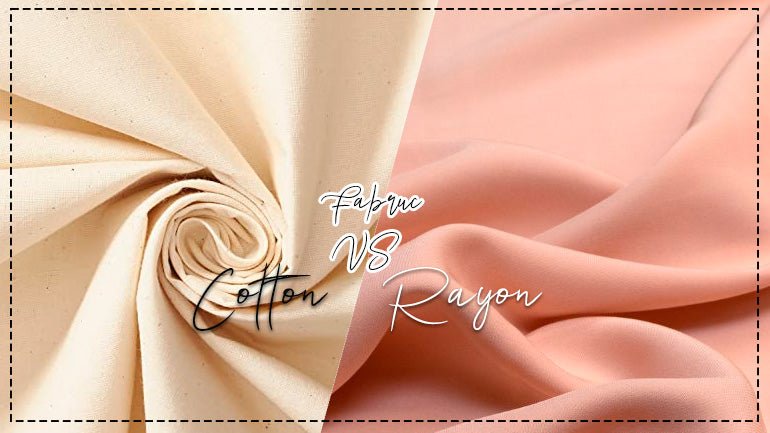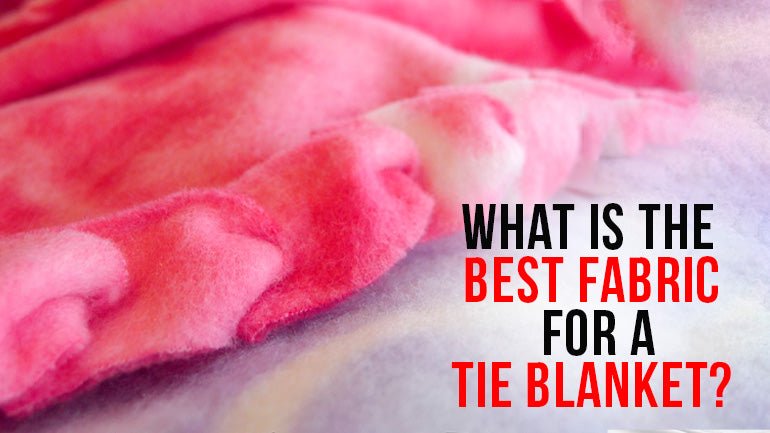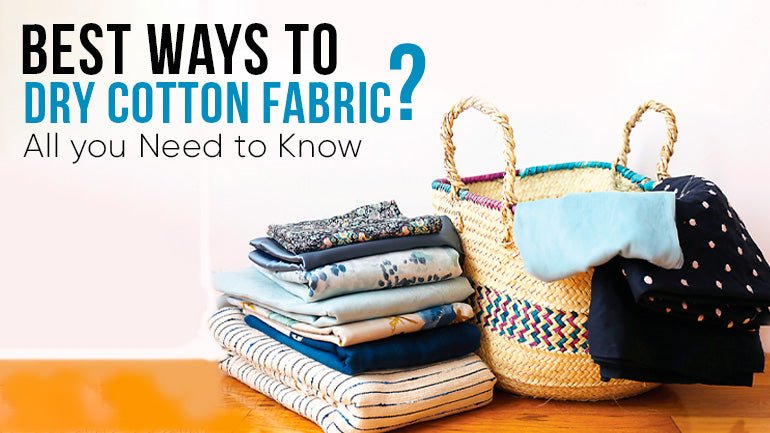In the vibrant world of textiles, cotton and rayon stand out as two of the most sought-after fabrics, each bringing its unique charm and utility to the table. Whether you're on the hunt for the perfect material for your next clothing project or aiming to elevate your home décor, understanding the distinctive qualities of these fabrics is key. Dive into our expansive selection of buy cotton fabric online and rayon fabric for sale to discover the ideal textile that meets your needs.
Rayon can be described as a semi-synthetic textile, as is cotton, a naturally occurring material. In the case of rayon vs. cotton, it can be more absorbent than cotton. Cotton is an insulating fabric, but rayon is known as a non-insulting fabric. Rayon is a fabric that can be used in humid climates, whereas cotton is a better choice in warm climates.
Rayon gets weak when wet. The cotton fabric is stronger when it's wet. The cost of cotton is higher than rayon. The most significant thing to note about both fabrics is that rayon is used for fashion, but cotton is used in the medical field. By understanding what is the difference between cotton and rayon, you can make informed choices when it comes to selecting the right fabric for your needs.
What is Rayon?
Rayon, often dubbed a semi-synthetic, biosynthetic, or regenerative material, was first developed in the late 1800s as an alternative to silk. Unlike silk, which comes from silkworms, rayon is derived from processed cellulose originating from wood or bamboo. This raw material undergoes extensive chemical processing to transform it into a luxurious fabric that closely resembles silk, both in look and feel.
Read on to find out more about What is Rayon Fabric?
How is Rayon Made?
The process from wood pulp to silky threads involves several intricate steps. It all begins with wood pulp extracted from sources like bamboo, beech trees, or pine trees. This pulp is then dissolved in sodium hydroxide, resulting in a substance known as alkali cellulose. Subsequently, the alkali cellulose is soaked in carbon disulfide, leading to the formation of cellulose xanthate. This product is then extruded through spinnerets into tiny filaments, which are finally spun into fine, silky threads.
One of the defining features of rayon is its versatility in weaving. Different weaving techniques produce various appearances. For instance, knit rayon resembles a fine, knitted sweater with loops, while a satin weave imparts a lustrous, smooth surface.
A chiffon weave creates a slightly puckered, silk-like texture. Regardless of the weave, rayon consistently boasts a lightweight, silky feel, excellent drapability, and the ability to hold its shape in pleats or ruffles. Furthermore, it retains color well, allowing for a wide range of vibrant designs in rayon garments.
What is Cotton?
Cotton is a natural fiber obtained from the fluffy fibers found inside cotton bolls. These fluffy white fibers have been cultivated and processed for thousands of years, with cotton's softness and strength making it a staple fabric in various parts of the world.
Historically, the cotton industrial revolution in Britain marked a turning point, enabling mass production of fabric on an unprecedented scale. Unfortunately, the demand for cotton played a role in the unethical practice of enslaving people in the United States and British-governed regions.
Get the complete story on What is Cotton Fabric?
How is Cotton Made?
Cotton cultivation is labor-intensive and requires substantial water resources. Modern cotton picking is facilitated by machines, which efficiently pluck the cotton bolls from plants. Subsequently, a machine known as a gin separates the fibers from clinging seeds. After this initial processing, the cotton is cleaned, pressed, and sent to manufacturers for further refinement.
To transform raw cotton into usable thread, the fibers often undergo carding, which aligns them into loose strands. These strands are then spun into large spools of yarn, allowing manufacturers to create a wide range of cotton fabrics, from jersey knit for t-shirts to percale weave for luxurious bedsheets.
Key Differences Between Rayon and Cotton
Origin
Cotton: Cotton is a natural fabric that has been a staple in the textile industry for centuries. It is derived from the seed pods of the cotton plant, known scientifically as Gossypium. The remarkable purity of cotton arises from its composition, which consists of nearly pure cellulose.
Cotton cultivation and processing are deeply rooted in history, with evidence of cotton use dating back thousands of years.
Rayon: Rayon, in contrast, is a semi-synthetic fabric created from cellulose fibers. These fibers are typically sourced from wood pulp, although other sources like bamboo and soy have been used as well. This blend of natural cellulose and synthetic processing methods distinguishes rayon from cotton and grants it unique characteristics.
Durability
Cotton: Cotton is popular for its durability, especially when it is dry. It has the ability to withstand regular wear and tear, making it a favored choice for everyday clothing and a wide range of textiles, including bed linens, towels, and more. The strength of cotton fibers contributes to their long-lasting nature.
Rayon: Rayon, unfortunately, exhibits lower durability when exposed to moisture. It is weaker when wet, which means that it is more susceptible to damage in humid conditions or when subjected to moisture, limiting its durability in certain situations. This characteristic can affect the longevity of rayon garments, making them less suitable for heavy-duty use.
Softness
Cotton: Cotton fabric is renowned for its soft and comfortable feel against the skin. Its natural softness makes it a popular choice for items that come into direct contact with the body, such as t-shirts, underwear, and pajamas. The breathability of cotton further enhances its comfort.
Rayon: Rayon, although not inherently as soft as cotton, can closely mimic the gentle touch of natural fibers. It is a suitable alternative for those seeking a luxurious texture without sacrificing comfort. Rayon's softness is especially appreciated in garments like dresses and blouses, where comfort and drape are essential.
Elasticity
Cotton: Cotton fibers lack inherent elasticity, which means that cotton fabrics have limited stretch. They tend to retain their shape and size, which can be an advantage for maintaining the structure of garments over time. However, this lack of stretch can sometimes limit mobility and comfort.
Rayon: Rayon possesses some degree of elasticity, allowing it to drape well and fit comfortably. This elasticity makes it a favored choice for clothing with a flowing and flattering silhouette. Garments made from rayon can provide a more form-fitting look while still allowing freedom of movement.
Absorbency
Cotton: Cotton is highly absorbent, making it an excellent choice for items that need to wick away moisture. Towels and bed linens made from cotton efficiently absorb sweat and water, keeping you dry and comfortable. This absorbent quality is one of cotton's most celebrated attributes.
Rayon: Surprisingly, rayon is even more absorbent than cotton. This property makes it ideal for use in humid climates or for items that require superior moisture-wicking abilities. Rayon garments can help keep you feeling cool and dry in challenging conditions.
Wrinkling
Cotton: One drawback of cotton fabrics is their tendency to wrinkle easily. Maintaining a neat appearance can be a challenge, and frequent ironing or steaming may be necessary, especially for formal attire.
Rayon: Rayon, while not completely immune to creasing, is generally more wrinkle-resistant than cotton. This means that rayon garments tend to maintain a smoother appearance, even after prolonged wear or storage. However, it's important to note that rayon can still wrinkle, especially if it is tightly packed or not stored properly.
Sustainability
Cotton: The sustainability of cotton largely depends on how it is cultivated and processed. Cotton is a natural and renewable resource, making it an environmentally friendly choice when managed responsibly. Organic cotton farming practices, for example, prioritize sustainability by avoiding the use of synthetic pesticides and adopting water-efficient methods.
However, conventional cotton farming can raise concerns due to the use of pesticides and water-intensive practices.
Rayon: The sustainability of rayon is more variable and depends on the source of the cellulose fibers and the manufacturing process. While some rayon production methods can be environmentally friendly, such as those using sustainable wood pulp sources and closed-loop processing systems, others may involve chemical-intensive processes that raise concerns about sustainability.
It is crucial for consumers to check the source and production methods of rayon products to make eco-conscious choices.
Care
Cotton: Cotton fabrics are relatively easy to care for. They can typically be machine-washed and tumble-dried without issue. However, it is essential to follow care instructions to avoid common pitfalls like shrinking and excessive wrinkling. Different types of cotton may have specific care requirements, so always check the label for guidance.
Rayon: Rayon garments often require special care, which can be a consideration for buyers. Many rayon items need to be dry-cleaned, as washing them in hot water or using a regular washing machine can damage the delicate rayon fibers. Some rayon pieces may be hand-washed in cold water, but it's essential to check the label for specific care instructions to ensure the longevity of the fabric.
Cost
Cotton: Cotton is generally more costly than rayon, especially when considering premium, hand-picked varieties. However, many consumers find that the durability, comfort, and versatility of cotton products justify the higher price point. In the long run, cotton's longevity can make it a cost-effective choice.
Rayon: Rayon is known for being a more budget-friendly alternative to cotton. Its affordability makes it accessible to a wider range of consumers, making it an attractive choice for those seeking quality textiles without a hefty price tag. While rayon may be less expensive upfront, it's essential to consider its durability and care requirements when evaluating its overall value.
Uses
Cotton: Cotton is an incredibly versatile fabric that finds applications in various industries, including fashion, medical, and home textiles. Its natural properties make it suitable for a wide range of products, from clothing items like t-shirts, jeans, and underwear to bed linens, towels, and curtains. In the medical field, cotton's absorbency and hypoallergenic qualities make it a preferred material for wound dressings and fluid absorption.
Rayon: Rayon is commonly used in the fashion industry for clothing items such as dresses, blouses, and shirts. Its ability to mimic the softness of natural fibers while offering drape and elasticity makes it a favored choice for creating garments with a flowing and flattering silhouette.
Rayon's breathable nature also makes it a good option for warm-weather clothing. However, due to its lower durability when compared to cotton, rayon may not be the best choice for heavy-duty or long-lasting applications.
For those seeking the luxurious drape and softness of rayon fabric, you're in luck. Check out our wide range of exquisite rayon fabrics that are perfect for various projects. Click here to buy rayon fabric and add a touch of elegance to your wardrobe and interior designs.
Comparison table: Rayon vs Cotton
|
Feature |
Cotton |
Rayon |
|
Origin |
Natural fabric from cotton plant |
Semi-synthetic, made from cellulose fibers |
|
Durability |
Highly durable when dry |
Weaker when wet, less durable in moisture |
|
Softness |
Naturally soft against the skin |
Can mimic softnesbas but not as natural |
|
Elasticity |
Limited stretch and retains shape |
Has some elasticity, drapes well |
|
Absorbency |
Highly absorbent, ideal for moisture-wicking |
Even more absorbent than cotton |
|
Wrinkling |
Wrinkles easily, requires more maintenance |
More wrinkle-resistant, maintains smoother appearance |
|
Sustainability |
Depends on farming practices |
Variable, depends on source and processing |
|
Care |
Machine-washable, tumble-dry |
Often requires special care, may need dry cleaning |
|
Cost |
Generally more expensive |
More budget-friendly |
|
Uses |
Versatile, used in fashion, medical, home textiles |
Commonly used in fashion, less suitable for heavy-duty items |
If you're interested in experiencing the natural comfort and breathability of cotton fabric, you can explore our collection of high-quality cotton fabrics. Click here to buy cotton fabric and elevate your clothing and home textiles with this versatile material.
Expand your knowledge on Cotton vs Poplin.
FAQs
Does rayon look and feel similar to cotton?
Rayon can mimic the softness and texture of cotton, making it look and feel similar to cotton. However, there may be subtle differences in the way they drape and their response to moisture.
What is more breathable, rayon or cotton?
Cotton is often considered more breathable than rayon due to its natural fibers and absorbency. Cotton allows air to circulate, making it a popular choice for hot and humid climates.
Is rayon better than cotton in summer?
Rayon can be a good choice for summer clothing due to its moisture-wicking properties, which help keep the wearer cool and dry. However, cotton is also a suitable option for summer due to its breathability and comfort.



